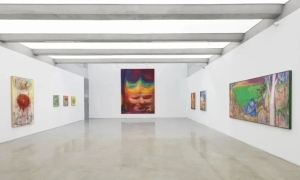山下烟霞山上楼,
丹梯蹑足小勾留。
置身已在烟霞上,
还有烟霞最上头。
清.刘源禄《华楼》
天籁远出
秋入京华,访官书院,遗构荡然难寻,见一座气宇轩昂的老屋被一群破乱不堪民居环抱,我几经周折接近瞻仰,老屋看来已年久失修,满身斑驳,默默卧虬于杂草荆棘和百虫群蛙之中。怎这般形态?想当年这里一定是“穿花蛱蝶深深见,点水蜻蜓款款飞”的景象。
我蹑手蹑脚、轻轻地、缓缓地拨开丛丛杂草,环绕老屋细察,老屋的魂魄与现实如同清尘浊水,浮沉异势。刹那间,见墙根嵌有一块乌青石,石上有依稀难辨的几行龟兹文,我乘着一缕缕杂草摇曳间的光影,断断续续地辨认石上碶刻的文字,一个时辰方才罢了,真可谓,青山遮不住,顿觉奇妙,这乃是一段失传千载的《呱呱天籁远出记》,此文大意是这样的:
呱呱天然浑成,胸怀远志。顶盔挂甲,饕餮面饰,系挟缆裙,藻服束丹,身披弥云飞天神符。望脸上看:乃是鼻直口方,两耳有轮,九连白羊大象眼。手持一柄开山板门金刚虎齿鹤头杖,跨下一匹闪电得劲白龙驹。一路风尘万千,与各色妖魔斗智斗勇,力排万难,驰骋不息。
乘着朝阳,越火焰山,与铁扇公主同饮美酒,酒后携手走葡萄沟,横跨戈壁滩,满目仙境。呱呱与公主一口气跑到了天山脚下。公主对呱呱说,你往山上看,能看到什么?呱呱顺着公主所指方向看了再看,是一片皑皑雪山,顺着雪山向远处看,还是一片皑皑雪山。公主说,你喝碗狗肉汤,提提神,你再看,使劲看。呱呱鼓足了劲,抖出浑身解数集于九连白羊大象眼向雪山聚气凝视,看了又看,直看得昏天黑地才看到了山顶上一朵雪莲花。公主说,呱呱,再透过雪莲花瓣,还能看到什么呢?呱呱灌下一碗五龙背魔血玄蛇天禄灵狐火轮汤,振作了元气,目光穿透了黑云沙海,蛮荒神巫,再穿越了片片花瓣,终于洞见了一束云天之外沁人心脾的透明。此刻,天籁四起,呱呱满目天工开物的光芒。
天工开物
这就是王怀的《天工开物》。
两片黑色的大木框呈丁字型嵌在一起,每片木框高4.5米,宽3.5米。这两片木框的连接有四种以上榫卯,根据木框上下左右不同的连接形态,形成了不同视觉时态下的不同结构。第一种是榫头插进去,但没有插到底,第二种是榫和卯插到底的,第三种是把榫和卯完美平放的,第四种的榫和卯不是四十五度角,是有空隙的。木框是正方形的,但木框里面的边线不是正方的,每一条边不是绝对平行的,所以在里面也形成了一个带角的不规则的四方形,从整体的造型看,形成了正确与不正确之间的参照系。这种不规则的正方形,和中国的建筑、家具中的榫卯结构的造型都有一定的联系,相互透通,但又在一个很规则的很限制的空间中若即若离地相通。在木框的侧面约1.5米高处有多个大小不一的小孔,孔很细窄,观看者要上下左右反复移动目光,才能在一个错位相切的孔中看到远处的光照。而且,观者要微一低头才能看见这个孔,这样的视觉位置更能吸引观者从孔中凝望,如果直着就可以看到,就显得太简单了。因此,王怀在琢磨观者的视觉状态和心理状态,要在有限空间里,发生一个寻与找的过程。
冲天也有孔,那个孔有点像哥特式教堂的尖顶,很透但是很窄,带有一点神秘性。站在地上一抬头可以看见天,这就是中国人的宇宙观和人生观。早在新石器时代,古人对意识、精神和情感已拥有了初步的认识,认为意识和精神会升天,因为物质会消失,精神是不会消失的。因此,古人在陶罐的顶部开个孔,意识和精神可以从孔中自由出入,来往于天地之间,直至唐人皎然超越了有限的取境法度,道出了:“积疑一念破,澄息万缘静。世事花上尘,惠心空中镜”的心识。一晃眼,这又形成了《牡丹亭》里营造的超日常的时空。所以,人类的意识、精神和情感可以通天的思想一直薪火相传,直至留在我们的心中。近年设计的轩辕黄帝陵的建筑天顶就是一个硕大的空圆顶,是一个没有顶的建筑。是不是所有的黄帝子孙步入此处时,意识和精神都能通天呢?我想这是对天人合一理念的一种引喻,一种雄心,一种象征。因此,当我们仰头透过天工开物顶部的孔会看到天空,看到飞翔的大雁,也会看到心中的雪莲花。所有的人都可以在此得以飞天,只有踏在云上才能体会到王怀延伸了古人这种启迪、遐想和胸怀,让世人超级链接《天工开物》中的物境、情境、心境,一起仰首踮足,再一起豁然开朗。
此刻,《天工开物》成了人与人、人与现实、人与理想和人与未来之间的节点,也是传统与现实在同一目光中的相遇,所有从孔中凝视者都伸出了飞翔的翅膀,化为天工。当观者平视对望到光明,觉悟的那一刻,即开物了。作品对观者来说,是可以跨越、可以走动、可以凝视的。所有观者的动作都被巧妙地挪用,并构成了作品本身的一部分,让每个观看的人都有一种不同的感受。作品本身就成为了人与人凝视的一个中介,观者变成了真正的主体,这样,作品的角色就一直在变幻,作品意境也就非常之广阔。
由此,《天工开物》只有获得了有意无意地参与,作品才能横绝太空,意义才能超以象外。
如意天下
王怀选用了软金属,天工般的揉捏,在意与象之间营造了一个气韵生动的如意,无疑,通过如意放大了整个中国文化的象征,人文的企盼,百姓的渴望。可是当人们走近如意时,看到的一面是如花似锦的灿烂,另一面是腐朽糜烂的恶毒。两个不同且无法分割的完整世界,合为一体即成意义上立体的如意。如果说,王怀的《天工开物》揭示了现实世界中平视间的生活感悟;古往今来的宇宙观和人生观,那么《如意》则是切开了人类内心和造化的切面。狠狠地解剖了人性中的多面性和复杂性,这不是简单的囿于人面兽身或兽面人身的造型,而是直指内心深处的真实性,在社会生活日趋现代化的进程中,这已成为了现代人心理的倾向性和普遍性——既抒情又狰狞的如意。
美好的生活,这是个传统的理想。今天我们的理想变得耀眼且无序,在这个人们把理想转变成美丑同体的时代,无疑引人思考。中外历史上也有许多容貌艳丽,内心邪恶的人物,比如克丽奥佩特拉七世,她被称为“埃及艳后”,是一个“无与伦比的美女”,集情人、母亲、战士、女王于一身。她不仅美丽,也很有政治头脑。她利用自己的美艳和智慧,依靠凯撒的力量,从叙利亚重返埃及,执掌大权,而她也成为了凯撒的情妇。凯撒死后,其部将马克安东尼又成为这位埃及艳后的情人。最后,在与渥大维争权失败后,安东尼和克里奥派特拉相继自杀。在中国传统文化中也有类似的人物,《封神榜》中的妲己是一个被九尾狐精附身的美艳无比的女子,其个性残酷,怂恿纣王残害忠良,滥杀无辜,创出炮烙、锤击、蛇咬等可怖酷刑和一连串令人发指的恶行,最后以祸国妖女之罪被处死。
这是人的内心与现实之间的冲突。在漫长的人生过程中各种各样的起承转合,形成了人们善恶难分的普遍性。而王怀的智慧和勇气在于把善与恶、美与丑的两重性,巧妙地寄生于美好载体——如意。灿烂和腐朽相互寄生,好像是一块三明治中的肉和菜合在一起,咬一口就全部吞入胃中。此刻,灿烂与腐朽就像无法分割的细胞日夜周游于我们的体内,形成了我们的血液,甚至性格,构成了我们日常生活中的波澜和心理流变中的暗礁。
同时,《如意》也启发了我们另一种思考,我们以前只习惯从健康中提炼健康的疫苗,其实,从病菌中提炼,仍可以着手成春。王怀的思考与实践已离开了常态下的审美和美学,超越了日常的人生价值和美学价值,尝试着从罂粟中品到妙机。正如许多禅宗故事那样,初一看,可能是反常理的,甚至是胡言一派。如明明想说的是东,禅宗却和你说个西。但只要能觉悟其深意,就不辩自明,无论是精神,还是情感,顿觉一片灿烂。
思与境偕
《天工开物》和《如意》这两件作品,一个是扛鼎凝重的,另一个是婀娜多姿的,两个不同的视觉世界,可精神上是一以贯之的,王怀手里总是握住一根线,这根线中饱有中国传统精神,当这根线握得越来越紧,传统精神就越来越能激发出他新的艺术生命。进而从观念的拓展到形式的演变,这就是吴冠中讲的“风筝不断线”。王怀从1970年代开始在形式主义道路上思考与探索,从最早的求索变形构成到绍兴的故园,再到解构明清的家具,一路走来。现在,这两件作品一下子把近三十多年来的思考与探索都活化了,如同打通了经脉,奔腾自如,将历史与现实叠加在一起。它们和王怀以前的平面作品相比,不但形成学术思路的连贯性,而且形成了新的视觉冲击。就如同在平面几何的测量中,两点之间距离是最近的,但在宇宙空间中,两点之间的距离却成了一条弧线,可能不是最近的,因为空间不一样了,标准也不一样。这两件作品的诞生就是王怀对人生观和价值观的转折,由此而形成了将艺术表达提升到行神如空,行气如虹的境地。因此,无论从艺术思想还是艺术表现都是一个较大的转折——思与境偕。
离形得似
呱呱在天山脚下看了三天三夜天工开物之盛景,继续向前!一路颠扑不破,尘土飞扬,饿得双目闪闪,来到了阿勒泰山东段诺尔特峰下的诺尔特湖,这里山石峥嵘,奇峰凌空,白雪皑皑,银光四射。但见王怀赤膊跳入零下三十度的湖中游泳,呱呱问王怀:“冰湖冷不冷呵?”王怀笑答:“冰下是最暖和的世界。”呱呱捡起一辆摩托摇头摆尾地上路,从诺尔特湖向布伦托海狂奔,这一段路崎岖险阻,高低不平,远处的美景已难辨真伪,如同在穿越真实的幻象与虚拟的时空,飞奔中,呱呱的前轮冲进了山沟,一时惊惶失措,闭上双眼,踩足油门,腾空而起,单轮落地,这破摩托也全身骨折了,趴在阵阵飞土中,贴上几张乌伦古琥犩兕火牦伤骨膏药,波澜起伏地飞驰到布伦托海畔。
呱呱已一身灰泥浃汗,跳入海中洗心涤神,巧逢一群雅罗鱼曳入呱呱口中游赏,正好一顿大补。吃饱了鲜鱼便放眼望去,烟波浩淼,水天一色,天鹅浮游,海鸥翔集。远处依稀可闻:如意天下!
2007年深秋于海上跑马场钟楼
Traces of Nature
Art of Wang Huai Qing
Zhang Qing
[I see] mist and glowing clouds at the foot of the mountain, and a tower in the mountain.
Walking uphill on the stairs
[I am] surrounded by mountain mist and clouds.
The best mist and the clouds are yet to be experienced
on the top of the mountain.
-Beautiful Tower by Liu Yuanlu
Heavenly Sound Arisen
In an autumn day, I visited Guan shu yuan in Beijing, where ancient scholars studied. I was disappointed to find an abandoned building in a dilapidated residential area. My imagination took me to a magnificent place where flowers bloomed, and butterflies and dragonflies played.
The building’s history and current condition strangely mixed in my mind. I walked slowly around the building. Suddenly in the wall, a stone slab hidden in the weed caught my attention. I examined the slab carefully and found an obscure inscription in qiu ci writing. It took me a few hours to read the inscription. It was the lost literature entitled The Long Journey of Gua-gua in the Heaven. Gua-gua was a mythological warrior who tirelessly fought all kinds of evil spirits. He had elephant eyes and wheel-like ears. Carrying a crane-head staff, riding a white horse, he was the symbol of wisdom, strength, and triumph. One morning, he passed the Flame Mountain and drank with Iron Fan Princess, who was in charge of the Flame Mountain.1 Then he traveled with her to the beautiful Grape Valley and the Gobi dessert. When they arrived at the foot of the Tianshan Mountain, the princess pointed to the mountain and asked Gua-gua, “What do you see?” Gua-gua looked up. He saw nothing but ice and snow. The princess suggested that he should drink some energizing soup and looked again. Gua-gua followed her advice. He looked again and again, and reported to the princess that he found a snow lotus lily. The princess asked, “What else?” After drinking a bowl of more powerful soup, Gua-gua saw a clear sky emerged from black clouds, the sand storms, and flower petals. At this moment, he heard heavenly sounds and saw the mysterious and wondrous light of creation.
Traces of Nature
This realm is what Wang Huaiqing’s work entitled Traces of Nature creates. His piece consists of two jointed black wood frames, measuring 4.5x3.5 meters each. The artist employs more than four kinds of joint to connect these two frames, which produces a variety of visual effects. In the first kind of joint, the end of the tenon, a protrusion in one frame, meets the bottom of the mortise, the corresponding cut out section in the other frame. In the second kind of joint, the ends of the tenon and the mortise do not meet. In the third joint, the ends of the tenon and the mortise, cut at an angle of 45 degrees, meet. In the four joint, the ends of the tenon and the mortise do not meet because they are cut at different angles. While the regular and straight outer edges of these two frames formed a perfect square, their inner edges constituted an irregular rectangular. With reference to classical Chinese architecture and furniture, the two jointed frames create a tension between regularity and irregularity, correctness and incorrectness in a limited space. About 1.5 meters from the bottom of the piece there are several small holes on the sides of the frames, which were designed with the artist’s awareness of the viewer’s physical and psychological responses to this work. In order to see the light that comes through the holes, average viewers need to bend over slightly and adjust their viewing positions. In this sense, viewers’ experience with this piece becomes a process of discovery.
Strongly reminiscent of the pointed and narrow Gothic spire, Wang Huaiqing’s Traces of Nature evokes a sense of mystery. In Chinese cosmology and philosophy, the sky/heaven is something we can immediately see when we look up. In the Neolithic period, people believed that the soul of the deceased would rise to the heaven because spiritual forces were immortal. For example, a hole was often created on the top of a funerary terra-cotta jar to allow the soul to depart and return to the jar and the human world freely. In the Tang dynasty, philosophers expanded their perceptions of time and space, as the poem illustrates, “One idea clarifies all the puzzlements in an instant. All things in the world become clear and quiet. Worldly affairs are dusts on flowers. The enlightened mind is an empty and clear mirror.” In the play by Tang Xianzu, the Peony Pavilion, the line between life and death, between dream and reality, became fluid. The Xuanyuan shrine that commemorates the Yellow Emperor embodied the Chinese concept of the union between humans and the heaven. The shrine features a “roof”, a circular opening from which visitors can see the sky, flying geese, and the snow lotus lily in our mind.
Wang Huaiqing’s work Traces of Nature creates a similar realm where the viewers can communicate with the heaven. It is an interface where viewers can have dialogue with the reality, dream, and the future. It is also a meeting place of the past and the present. This piece gives viewers wings of imagination with which they can communicate with the heaven, and obtained enlightenments. Viewers have a dynamic relationship with the work, which allows them to move around, to see, and to reflect. The work also creates different responses in viewers, and their experiences become an integral part of the work. For example, when some viewers interact with the work, they are observed by other viewers. Wang Huaiqing’s
piece is capable of generating multilayered and varied meanings for viewers.
The conscious and unconscious participation of the viewers is what makes Traces of Nature a compelling and meaningful work of art.
Ruyi-Symbol of Auspices
Wang Huaiqing’s piece entitled Sceptre refers to the lingzhi fungus, the symbol of wealth, good fortune, and immortality. Beauty and decay come together in an eerie way in the artist’s hand. While Traces of Nature is concerned with time and the universe, Sceptre reveals the complexity of our inner world, where different and even contradictory elements go hand in hand. The tension between the opposing forces in our mind is foregrounded in modern society where the boundaries between beauty and ugliness, the good and the evil are often blurred. Cleopatra VII offers an example in history. She was the supreme ruler of Egypt, as well as a mistress, mother, and warrior. With unparalleled beauty, intellect, and ambition, she consummated a liaison with Gaius Julius Caesar that solidified her grip on the throne. After Caesar's assassination, she aligned with Mark Antony. Defeated by Gaius Julus Octavian, she and Antony committed suicide. The legendary figure Da ji in the sixteenth-century novel, Feng Shen Yan Yi (The Investiture of the Gods), is the “Chinese Cleopatra”. A fox spirit in disguise, she charmed the King Zhou with her beauty, and created many cruel methods to punish innocent people. Finally she was sentenced to death.
Combining many opposing elements, Wang’s piece Sceptre reminds us of the contradictions and complexities in our life and mindscape. Sceptre also alludes to the transformation of opposing forces. For example, we try to avoid viruses. Paradoxically, it is from viruses that vaccines are created. Like Zen koans, Huaiqing’s works contain seemingly paradoxical even non-sensical elements, which inspire us to see our life and the world in a new light.
New Concepts and Expressions
Traces of Nature and Sceptre have different feels. The former is solemn and grand. The latter is lively. But both are rooted in tradition. Wang Huaiqing’s artistic practices are based on his profound understanding of Chinese traditions, from which new concepts and forms are generated. Wang’s use of tradition can be illustrated by the renowned painter Wu Guanzhong’s phrase, “ to run a kite with a line”. From the 1970s onward, Wang Huaiqing has been experimenting with various artistic forms, including abstraction, architecture in his hometown Shaoxin, and Ming and Qing dynasty furniture. His artistic exploration in the past three decades culminated in Traces of Nature and Sceptre. Compared with his two-dimensional pieces, these two new pieces are more powerful in form and concept. In a two-dimensional surface, two points can be connected by a single line. But in a three-dimensional space, there are many new ways to connect two points. Traces of Nature and Sceptre with new concepts and expressions marked a turning point in the artist’s life and career. They created a realm where grand forces move freely.
Abandoning Formal Likeness
to Obtain the Essence
Gua-gua watched the spectacle of creation in the sky for three days. He continued his journey. When he arrived the lake at the foot of Mt. Nuo-er-te in the Altai mountain, he saw Wang Huaiqing swimming in the lake. The water temperature was about 30 Celsius degrees below zero. He asked Wang, “Isn’t the water cold?” Wang responded to him with a smile, “ The world under the ice is the warmest place.” Gua-gua took a motorbike to rush to Bu lun tuo lake. The road was rugged. His motorbike fell apart. After a quick repair, he resumed his trip.
When Gua-gua arrived at the lakeshore, he jumped into the water to wash his dusted and sweaty body. After enjoying a dish meal in the water, Gua-gua looked at the beautiful and serene scenery. The line between the big sky and the vast expanse of water was blurry. The lake was laced with white swans and singing sea gulls. Peaceful is the universe.
Autumn, 2007
[Translation by Wang Yiyou]
1 The Iron Fan Princess is a character in the novel the Journey to the West.
【编辑:贾娴静】





















